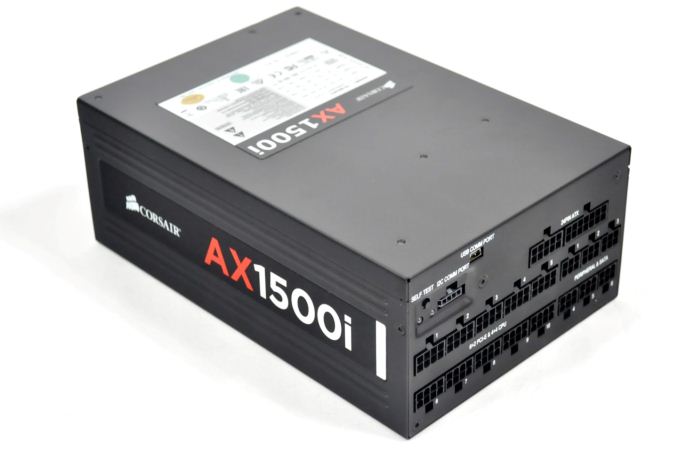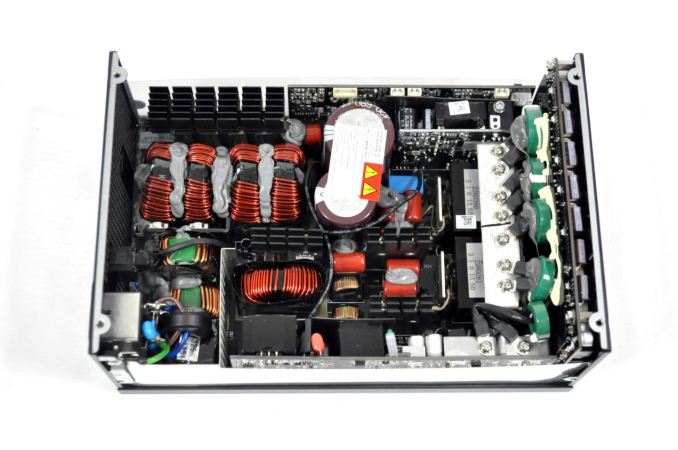Corsair AX1500i Power Supply Review
by E. Fylladitakis on September 11, 2014 5:00 AM EST- Posted in
- Cases/Cooling/PSUs
- Corsair
- PSUs
- 1500W
Conclusion
The AX1500i is definitely a special kind of product. It aims not for a particular group of users, but for the cream of hardcore overclockers, enthusiasts, gamers, and professionals. In other words, it targets users that both have crazy power requirements and, at the same time, require excellent overall performance. Of course, if you do not possess a very power-hungry system with multiple high end GPUs and CPUs, the massive output of the AX1500i would not make any sense to begin with.
Both externally and internally, the AX1500i has been very carefully designed and built. It is aesthetically appealing without being extravagant and the fully modular design is appreciable on a unit with so many cables. Only the size of the chassis could become a problem in smaller cases but we can hardly imagine someone purchasing a $450 PSU with the purpose of installing it inside a run of the mill case. Inside the AX1500i, Corsair uses fine quality components and has one of the most detailed assembly jobs ever performed. They really cut no corners when designing and building this power supply.
When it comes to performance, the Corsair AX1500i is almost frightening. Starting with the efficiency, as the 80 Plus Titanium certification is one of the primary selling points of this product, the AX1500i has a higher average efficiency than the top efficiency many 80 Plus Platinum units can achieve. It also has exceptionally high efficiency at low loads, which is very useful for a unit of this output, as the power requirements of even the most power hungry systems while idling are just a few percent of this unit's capacity. The quality of the output is also breathtaking, with very low voltage ripple even under massive loads and unparalleled regulation. Furthermore, due to the high efficiency, the AX1500i emits only very low volumes of heat, allowing it to operate virtually fanless across a large portion of its capacity range. The Corsair AX1500i undoubtedly delivers the best all-around performance that we have seen to this date.
With the release of the AX1500i, to our eyes, Corsair has simply tried to create the very best power supply possible, regardless of the cost and market potential. They did succeed on breaking almost every performance record we can come up with for a consumer-grade PSU... but that includes the record for being the most expensive unit a consumer can currently buy.
With a retail price of $450, this is definitely not a product aiming for the masses. Using any 1500W PSU to power even a high-end gaming PC, let alone a basic Home/Office PC, would be the very definition of the word "overkill". Corsair's AX1500i is a PSU meant for the most advanced gaming computers and workstations, and only for those users that are willing to spend a few hundred extra bucks in order to get the very best there is.
It's doubtful most of us will ever use such a product, but just as the 80 Plus program brought higher efficiency power supplies to the masses, products like the AX1500i will inevitably have a "trickle down" effect. Seven years ago the cost of a good 80 Plus Bronze 1000W PSU ranged from around $250 to over $300. Such power supplies were mostly overkill even then, but today you can find them for less than half the price, and higher efficiency 80 Plus Gold PSUs aren't much more. It may take some time to get there, but undoubtedly we will see much of the technology in the AX1500i makes it's way into more reasonable products. You have to start somewhere, and R&D often starts at the top.












55 Comments
View All Comments
pleuph - Thursday, September 11, 2014 - link
Come back when you've got a 1.21GW model.davidgirgis - Thursday, September 11, 2014 - link
1.21 GW? 1.21 GW. Great Scott!How could I have been so careless? 1.21 GW, Tom? How am I gonna generate that kind of power? It can't be done, can it?
Marty, I'm sorry, but the only power source capable of generating 1.21 gigawatts of electricity is a bolt of lightning.
A bolt of lightning, unfortunately, you never know when or where it's ever gonna strike.
xerandin - Monday, September 15, 2014 - link
We do now.Dadunn1700 - Wednesday, October 21, 2015 - link
Lol. I'm sure he will Doc when the time machine is finished. ; )DanNeely - Thursday, September 11, 2014 - link
The use of a C19 cable instead of C13 is required to comply with IEC 60320. C13 is limited to 10A of current, or 1100/1200W of input power. C19 bumps the max to 16A.http://en.wikipedia.org/wiki/IEC_60320#Appliance_c...
mapesdhs - Thursday, September 11, 2014 - link
Heh, 16A... the perils of 110V. ;)Kinda expensive. I just keep hunting for used Toughpower 1475W XT units, saved more
than $1500 so far.
Ian.
JayTheKing - Saturday, September 13, 2014 - link
This would be a problem for New Zealand power points, as our max current draw is 10A @ 230/240. Only power point in our house that allows for more than 10A is the oven and hot water cylinder.DIYEyal - Monday, September 15, 2014 - link
Because you're at a higher voltage. You won't have a problem. 10A in 230v means 2300W. That power supply will draw maximum of 7 amps from the wall (1500W at 92% efficiency means 1620w from the wall, at 230v it means 7 amps)Galatian - Thursday, September 11, 2014 - link
I purchased this power supply over two months ago. It is superb, but those cables are awfully stiff!Chrispy_ - Thursday, September 11, 2014 - link
Article starts with "making an 80+ PSU is much cheaper and easier than it used to be" and then here's Corsair with their ridiculous $450 PSU for the 0.01% of people who incorrectly believe they actually need this much power.Halo product, useless for almost everyone.